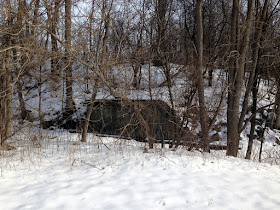The
Fonda, Johnstown and Gloversville Railroad (FJ&G) was formerly a 132-mile steam engine and electric interurban railroad that connected Fonda, Johnstown and Gloversville to Schenectady, New York. It had a successful and profitable transportation business from 1870 until the 1980s.
I spent some time this afternoon documenting the remnants of this system between Scotia and Amsterdam NY. The FJ&G ran along the north side of the Mohawk River and--although much of it has been obliterated by the widening of Rt 5--there were still a surprisingly good amount of places to see vestiges of the ROW.
Maps
These 1931 USGS topo maps indicate the precise ROW (highlighted in brown). It was a double track all the way between Schenectady and Amsterdam.
The FJ&G crossed under the
New York Central mainline at Washout Road and turned westward.
Documenting the Right of Way (ROW)
At the foot of Washout Road, the abutment over the creek was much easier to see in the winter than last April when I scrambled thru the briars to snap photos. see
April Post >
 |
| Washout Creek |
The widening of Rt 5 over the years obscured some sections but in other spots the roadway was easy to discern just to the north.
 |
The three photos above are (1) view from the road; (2) a small culvert; and
(3) a climb up to view the ROW looking eastward |
 |
| Certain sections of the ROW were visible in the distance |
 |
| A turn up a side road permitted close ups |
Verf Kill
Remnants of the bridge over the Verf Kill.
 |
| View from Rt 5 |
 |
| Up hill on a side street - I walked eastward on the rail bed cut |
 |
| Abutment |
 |
| View down from the edge |
 |
| Looking upstream |
 |
| Looking westward on the same side road |
Traveling further west

 |
| Visible in Bing Bird's Eye views |
 |
| Another side road view |
Further west, where the ROW ran closer to Rt 5, only a skinny width remains...
Abandonment
In 1938 the Gloversville to Schenectady line was abandoned.



























































